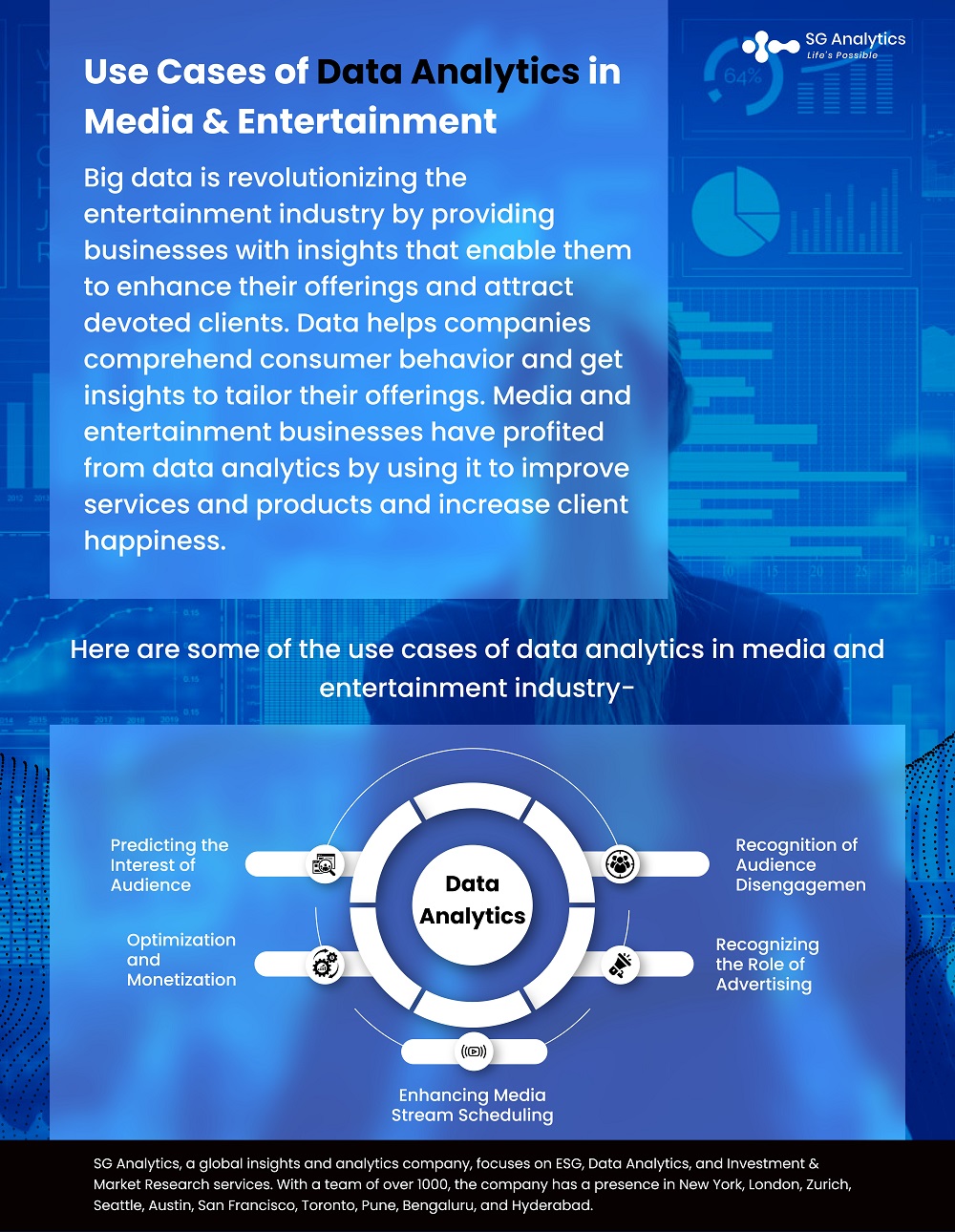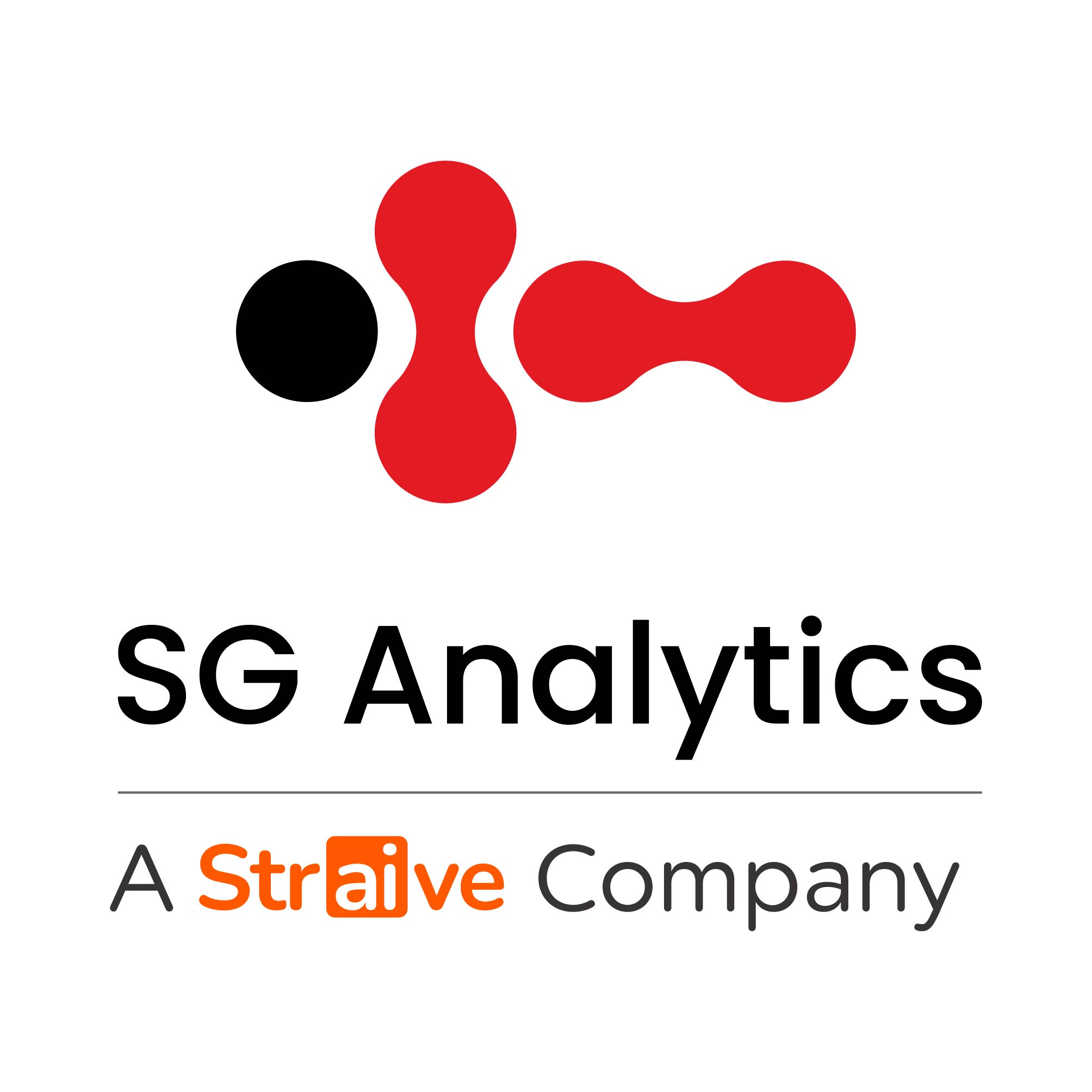The global entertainment and media sector is witnessing an era of popularity of movie and television material streamed over the internet (also known as “over-the-top,” or OTT).
According to a recent analysis from the global consulting firm PwC, the sector, which saw a decline in revenue due to the pandemic, is predicted to return quickly and rise by more than a quarter by 2025.
Rise of Data-Driven Entertainment
The media and entertainment industry is evolving constantly, and data analytics is emerging as a game-changer in shaping the landscape. From predicting box office success and understanding audience preferences to delivering personalized content recommendations, data analytics is becoming an indispensable tool for the industry.
This transformational integration of big data and analytics is not just reshaping content creation and distribution but is also redefining the landscape of media and entertainment software development. As these technologies evolve, their impact is becoming increasingly pronounced, predicting a new era of personalized and immersive entertainment experiences.

Media and Entertainment Industry: Today’s Scenario
Consumer behavior quickly changes as the globe gets used to a new normal. At-home digital media like OTT platforms, which are now reaching new demographics and places, are in high demand. Because of this, technological development has become essential in bringing outside entertainment to consumers’ homes.
There will be an increase in new users and the retention rate of current digital customers. As technology improves significantly assists them, demand for OTT originals and online games will only rise.
The best thing is that they do not rely on advertisements because their business strategy is subscription-driven. Even if television is undoubtedly here to stay, OTT will see significant growth in the meantime.
Additionally, media and entertainment businesses are relying more on technology to maximize cost efficiency and increase revenue growth. Profit protection and cash management are becoming more strategically crucial for media and entertainment organizations.
Influence of Data Analytics on Growth in the Media and Entertainment Segment
Big data and analytics are playing a critical role in revolutionizing the entertainment industry through software development. These technologies are not just emerging as tools for innovation but also as key drivers of growth.
The impact of data and analytics extends beyond content personalization and strategic decision-making. It is significant in influencing the overall growth and success of the sector. This influence manifests across different aspects of the industry.
- Drive revenue growth
- Streamline operations
- Enhance competitive advantage
With the influence of big data and analytics in media and entertainment on the rise, it is becoming evident that these technologies are pivotal to the industry’s future trajectory. They’re not just reshaping existing practices but also paving the way for new approaches and business models in this rapidly evolving sector.
Role of Big Data and Analytics in Entertainment
The transformative impact of big data and analytics in the media and entertainment industry is enabling the industry to strategically use data analytics to reshape the industry in several key areas, drive innovation, and enhance user experiences.
-
Personalized Content Recommendations for Enhancing User Experience
By analyzing viewer’s viewing habits, preferences, and interactions, these technologies will enable entertainment platforms to design content that resonates with individual tastes. This will result in generating a highly personalized user experience to keep the viewers engaged, ultimately boosting platform loyalty and retention rates.
-
Enhanced Viewer Insights and Optimization
Data analytics presents deep insights into viewer preferences, demographics, and behaviors, thereby equipping content creators and distributors with valuable insights for informed decision-making. This data is instrumental in shaping content strategies, scheduling releases, and guiding the creation of new content as per audience demands.
-
Use of Predictive Analysis for Content Creation
Predictive analytics helps anticipate future trends and viewer preferences, enabling the sector to stay ahead of the curve. By predicting potential successes, media and entertainment studios can make informed decisions about different projects, thus reducing the financial risks associated with content production.
-
Effective Advertising and Targeted Marketing Strategies
With detailed audience insights, organizations can create highly targeted marketing campaigns to resonate with specific viewer segments. This level of targeting will help enhance viewer engagement while ensuring a higher return on investment for marketing campaigns.

Read more: How Data Analytics Consulting Firms Empower Businesses with Insights
Use Cases of Data Analytics in the Media and Entertainment Industry
Let us look at the use cases of data analytics solutions in the media and entertainment industry trends that we will see in the upcoming few years-
-
Predicting the Interest of the Audience
Media outlets and entertainment channels can benefit from big data analysis, particularly those that rely on internet streaming. Since pleasing their customers’ opinions is their top priority, these channels strive to have the categories and material necessary to accommodate virtually all types of viewers while also focusing on the dominance of content diversity.
Big Data offers these powerhouses in media and entertainment a ton of classified data. The critical elements of this type of data that can assist companies in predicting a specific viewer’s interest include search history, ratings for each genre, social media trends followed, age, language, etc. Based on this, they can not only customize the viewer experience but also produce realistic and most-wanted program ideas.
-
Optimization and Monetization
Companies can decide to include a specific movie, for instance, in their content list just because it is hot and consumers would like to watch it, based on current trends and market releases. This might bring in more money for the businesses than usual because they usually monetize such unconventional material to keep viewers interested and draw in new users looking for the same stuff. They are more prone to use such message boards for fun.
As a result of how viewers responded to the show’s or movie’s trailers, there is also material where the firms decide to reserve a certain film or television program for a membership-only audience, which is often a paid subscription—requiring viewers to purchase a subscription to access these.

These businesses further attempt to attract users by making a certain episode or movie available for free before exclusive streaming to subscribers. Many entertainment companies, like Netflix, Hotstar, and Amazon Prime, achieve this by offering different materials to members and non-members.
-
Recognition of Audience Disengagement
Whatever business continues to find it challenging to deal with a customer’s departure in any industry, the same is true of these media and entertainment businesses; they provide membership for access to certain material essential to converting customers.
The price and term of membership are undoubtedly subjective decisions made by each organization, and they are frequently updated and amended. Big data also sheds light on recurring clients and devoted fan communities. In some instances, after receiving several push alerts and requests for action, members decide to opt out of the membership program rather than renew their subscriptions.
The media and entertainment companies need to pay attention to it to check for mistakes and out-of-date uninteresting information. Big data assists in obtaining the most current understanding of client behavior and enables businesses to change their content in response to platform demand.
-
Recognizing the Role of Advertising
The primary factor determining a company’s market worth and profitability is still advertising. Demands from advertisers for company analyses of their audience behavior are quite important. This can support relevant and individualized advertising at the appropriate time and location. Big data applications also assist in analyzing user behavior and what they are likely to buy through targeted advertisements.
Advertisements are typical and seem to be a natural component of any entertainment industry. This assists the businesses in acting as retargeting agents so that advertising will appear if people are watching a show or a movie with a connection to the items.
The spectator is more inclined to buy 3D glasses if they are marketed in the middle of a science fiction or technological film. The same may be observed in a fashion movie, which will imitate websites and direct viewers into purchasing goods like garments for the latest trends.
Big data not only helps customers and businesses to create content-related advertisements, but it also enables businesses to develop effective advertising strategies based on factors such as weather, timing, second-screen usage, etc. (as the online streaming platforms are multiple devices friendly)

Read more: Data Quality Management: Key Challenges and Solutions for Data Consultants
-
Enhancing Media Stream Scheduling
2.62 billion individuals have social media accounts, according to Statista. The barrier that once stood between distributors and end consumers has been lowered by the exponential rise of digital media distribution platforms. Big data in media & entertainment has made it possible to communicate directly with end consumers without the necessity of a middleman.
Big data analytics has also helped media companies interact directly with their audience through pre-scheduled video streaming and increased revenue. Big data has also assisted the Media and entertainment sector in pinpointing the precise content that customers would like to connect with regularly.
-
Increasingly Niche OTT Options
Through carefully selecting titles that are exclusively relevant to a certain interest or genre, niche OTT services appeal to a specialized clientele. To deliver top-notch, hand-picked content, they rely on a solid grasp of their target consumers and employ expertise rather than algorithms.
One of the most well-known specialized services is Crunchyroll, an East Asian anime provider with more than one million paying users. Another is Passionflix, which offers a variety of classic, romance-themed films and includes a grading system to gauge each movie’s “love” quotient.
Specialist services will be more competitive if they have flexible and reasonable pricing structures. One of the most eagerly awaited OTT platforms, DC Universe, also revealed further information before its Autumn debut. An option to pre-order a yearly subscription ($74.99) for an additional three months at no extra cost is shown in the price plans.
The Hindi production business Eros, for example, currently provides over 11,000 film titles and hosts more local material than Netflix and Amazon put together. In some cases, niche players create online communities by personalizing their content to certain groups.
While Netflix and other mass-market OTT services will continue to dominate the industry in terms of subscriber numbers, specialized services will appear to have a place in the market mainly if they can “provide everything for someone, rather than something for everyone,” as Crunchyroll’s CEO phrased it.
Read more: The Future of Data Governance: Top Trends to Watch Out For

Future of Data Analytics in the Media and Entertainment Industry
As we look into the future, the role of big data and analytics in the media and entertainment industry is set to grow even more influential. The next frontier involves incorporating AI and machine learning developments for more sophisticated data analysis and content personalization.
Integrating big data and analytics into the media and entertainment industry is laying the foundation of a new era. As these technologies continue to evolve, they are set to unlock more possibilities for creating engaging and innovative entertainment experiences. The rise of technologies, including AR and VR, further presents new opportunities for creating immersive and interactive entertainment experiences for the audience provided by big data.
A leader in the Media & Entertainment space, SG Analytics helps leverage advanced analytics capabilities to make accurate decisions and accelerate business growth. Contact us today if you are in search of media & entertainment solutions that enable businesses to solve problems by harnessing disruptive data, artificial intelligence, machine learning, and cutting-edge technologies.
About SG Analytics
SG Analytics (SGA) is an industry-leading global data solutions firm providing data-centric research and contextual analytics services to its clients, including Fortune 500 companies, across BFSI, Technology, Media & Entertainment, and Healthcare sectors. Established in 2007, SG Analytics is a Great Place to Work® (GPTW) certified company with a team of over 1200 employees and a presence across the U.S.A., the UK, Switzerland, Poland, and India.
Apart from being recognized by reputed firms such as Gartner, Everest Group, and ISG, SGA has been featured in the elite Deloitte Technology Fast 50 India 2023 and APAC 2024 High Growth Companies by the Financial Times & Statista.

